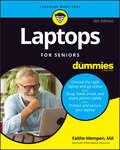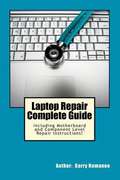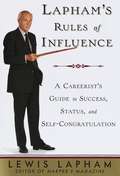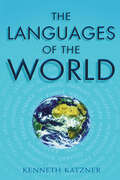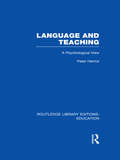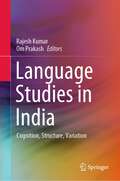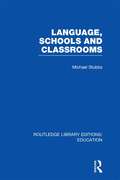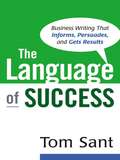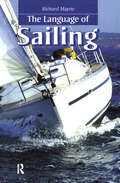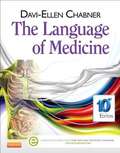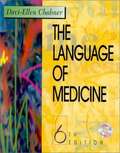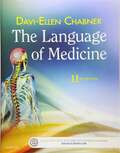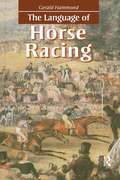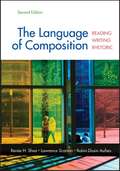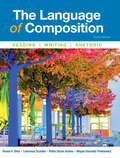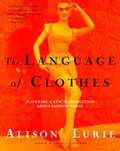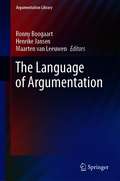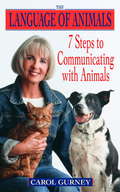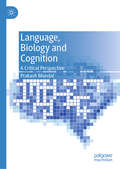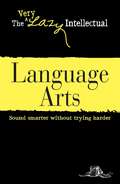- Table View
- List View
Laptops For Seniors For Dummies
by Faithe WempenThe basics you need to get more comfortable with laptops, without any of the fluff Laptops For Seniors For Dummies is just for you. We help readers in the 55+ club get the most out of their laptops. You&’ll discover how to choose the best laptop for your needs and how to use Microsoft Windows, to share photos, surf the web, use e-mail, and much more. With large text, clear graphics, and easy-to-follow instructions, this For Seniors For Dummies guide will get you up to speed on your new device in no time. Even if you&’re upgrading from a typewriter, we can help you choose the right laptop to buy, understand your operating system, use files and folders, download and install software, and stay safe online. It&’s all the stuff you need to know to make your laptop work for you. Choose and purchase the right laptop for your needs Navigate your Windows 10 or 11 operating system with confidence and discover useful programs Connect to Wi-Fi, go online, send e-mails, and get started with social media Protect and secure your laptop and your personal dataWhether you&’re purchasing your first laptop or upgrading from older technology, this Dummies guide will take you step by step through everything you need to know to get laptop savvy.
Laptop Repair Complete Guide; Including Motherboard Component Level Repair!
by Garry RomaneoThis book will educate you on the Correct Process of Repairing The Entire Laptop, Including and concentrating more on Motherboard Repair Instruction, Screen Repairing, Component Level Diagnosing and Repairing. This is the 3rd Book Released By Author Garry Romaneo, The Worlds Leading Laptop Repair Technician, Author, and Consultant. The book will take you through the laptops disassembly process, Explaining in detail how to disassemble all laptops. You will then be taught all about Liquid Spills to Laptops. What to do, What not to do, How to Remove Liquid and How To Repair Any Damage from Liquid to parts or components. You will be shown all the various tools to be used in laptop repair both hand tools and electronic tools explained. This book will then explain the entire upper end repairing techniques. Replacing screens - how to- then it will show you in great detail how to disassembly the screen and repair or replace the LCD ccfl Bulb, the book will also discuss LED screens. You will be taught step by step how to solder a motherboard whether it is the components or the dc jack. The DC Jack Repair/Desoldering instructions are included. Most importantly, this book will teach you laptop motherboard repairing techniques. Learn to identify the parts and components on the motherboard, learn component replacement, motherboard testing techniques and more. This book also includes the authors Patented/Copyrighted and Trademarked Laptop Video Chip/GPU Motherboard Online Repair instruction. There is alot more included (Part Identification, Hard Drive Failure Issues etc. . . )so check it out now. Going Above And Beyond CompTia A+ Certification !!!
Lapham's Rules of Influence: A Careerist’s Guide to Success, Status and Self-Congratulation
by Lewis LaphamAs the editor of Harper's Magazine, Lewis Lapham has enjoyed entrée to America's "cultural elite", a class distinguished by its talent for currying favor, licking boots, and kissing ass. Drawing upon a lifetime of experience among the cognoscenti, Mr. Lapham breaks rank and reveals the unspoken secrets of getting ahead: what to say, how to dress, when to lie, whom to befriend, where to be seen, and why it is absolutely essential to wear clean shoes. "The first impression is also the last impression. You don't wish to be remembered as the stain on the rug." Anyone interested in self-advancement will be transformed by Lapham's "Rules of Influence", which offers proven nuggets of wisdom. For example, when trying to impress the boss, remember: "Flattery cannot be too often or too recklessly applied. Think of it as suntan lotion or moisturizing cream." Written with stinging wit and tongue planted firmly in cheek, Lapham's "Rules of Influence" is a brilliant critique of class and manners in America, packed with the kind of irreverent observation that only Lewis Lapham can provide. Seek out the acquaintance of people richer and more important than yourself, and never take an interest in people who cannot do you any favors.
The Languages of the World
by Kenneth Katzner Kirk MillerThis third edition of Kenneth Katzner's best-selling guide to languages is essential reading for language enthusiasts everywhere. Written with the non-specialist in mind, its user-friendly style and layout, delightful original passages, and exotic scripts, will continue to fascinate the reader. This new edition has been thoroughly revised to include more languages, more countries, and up-to-date data on populations.Features include:*information on nearly 600 languages*individual descriptions of 200 languages, with sample passages and English translations*concise notes on where each language is spoken, its history, alphabet and pronunciation*coverage of every country in the world, its main language and speaker numbers*an introduction to language families
Language & Teaching: A Psychological View (Routledge Library Editions: Education)
by Peter HerriotLanguage is the basic means of communication in the classroom. It is therefore vital that teachers should know something about its acquisition, development, possible defects and the ways in which they may understand and develop its communicative powers. Peter Herriot describes the relationship with thinking, with personal and social development and its manifestations in the classroom. All this is described from the point of view of the psychologist and incorporates many of the findings of contemporaneous psychological research. But the author carefully avoids the jargon of psychology nor does he assume any prior knowledge of linguistics or psychology. Thus Language and Teaching should be especially useful to the student of education or those already engaged in teaching. It is a primer of communication.
Language Studies in India: Cognition, Structure, Variation
by Rajesh Kumar Om PrakashThis book addresses a wide range of aspects of the study of language in a variety of domains such as cognition, change, acquisition, structure, philosophy, politics, and education. It offers a renewed discussion on normative understanding of these concepts and opens up avenues for a fresh look at these concepts. Each contribution in this book captures a wide range of perspectives and underlines the vigorous role of language, which happens to be central to the arguments contained therein. The uniqueness of this book lies in the fact that it presents simplified perspective on various complex aspects of language. It addresses a wide range of audiences, who do not necessarily need to have a technical background in linguistics. It focuses on complex relations between language and cognition, politics, education to name a few with reference to cognition, change, and acquisition. This book is for researchers with an interest in the field of language studies, applied linguistics, and socio-linguistics.
Language, Schools and Classrooms (Routledge Library Editions: Education)
by Michael StubbsThe role of language is central in education – but there is much debate about the exact relation between children’s language and their educational success. The author provides a clear guide to the basic issues in the debates over language deficit, standard English and classroom language, and in this edition he shows how work in sociolinguistics can give a better understanding of the place of language in education and society.
The Language of Success: Business Writing That Informs, Persuades, And Gets Results
by Tom SantLanguage is the medium of business. To be successful, we need to communicate effectively in writing. That’s true whether we are providing instructions to our colleagues, communicating with our customers, or advising our direct reports. We must be able to deliver clear, accurate messages that inform, persuade and motivate. Unfortunately, people lapse into habits that interfere with their ability to communicate. The Language of Success shows readers ho to avoid these mistakes, and to write lucid, concise, and accurate e-mails, letters, performance appraisals, and presentations. Now anyone can master the lost art of clear writing and: * eliminate ambiguities, jargon and grandiose claims * master proper paragraph structure so the message doesn’t get muddled * avoid wishy-washy or misleading terms like "world class" or "state of the art" * write clear concise sentences that follow the "first time right rule" * use e-mail professionally and efficiently * create career-enhancing reports Honest and authoritative, The Language of Success will gives readers practical techniques to help readers cut through the fluff, guff, geek, and hyperbole, write exceptional business documents, and get their message heard.
The Language of Sailing
by Richard MayneThere have been many dictionaries explaining to laymen the technical terms of sailing. None of them, until now, has systematically set out to explore their etymology and evolution. The Language of Sailing demonstrates that many of the American and British words in question are derived-- often in complex and controversial ways--from other languages, mainly European. The diction of the sea, in fact, is a huge and hybrid skein, much of it traceable as far back as Sanskrit. It reveals that seafaring knitted Europeans together, sometimes in conflict and rivalry, often also in comradeship, when sailing crews could be as multinational as today's international conglomerates. The Language of Sailing is not intended simply for the entertainment of sailors and scholars. Anyone interested in the literature of the sea will find here an unusual and suggestive resource.
The Language of Organizational Styling
by Lionel WeeThe ways in which commercial organizations and service providers 'style' themselves - creating the image they wish to portray to their potential consumers - is a long-established area of research in the fields of sociology and business studies. However language also plays an important role in organizational styling, something which until now has been largely overlooked in the literature. This is the first book-length study of the linguistics of organizational styling, looking at the language and semiotic resources used by holiday resorts, pharmaceutical companies, restaurants and insurance companies in order to project their identities, and style themselves. It discusses in detail a number of case studies and presents an innovative take on the notion of style, as well as bringing together work from linguistics, business studies and sociology. This interdisciplinary book will be of interest to scholars and advanced students in sociolinguistics, and scholars of sociology and business studies.
The Language of Medicine (Tenth Edition)
by Davi-Ellen ChabnerBring medical terminology to life with Davi-Ellen Chabner's bestselling The Language of Medicine, 10th Edition By presenting medical terms within the context of the body's anatomy and physiology, and in health and disease, this proven resource makes it easy to learn a working medical vocabulary built on the most frequently encountered prefixes, suffixes, and combining forms. Practical exercises and case studies demonstrate how medical terms are used in practice. Add an engaging student Evolve website with medical animations and videos, word games, flash cards, and more, and you'll be ready to communicate confidently in the clinical setting and succeed in your healthcare career.
The Language of Medicine (6th edition)
by Davi-Ellen ChabnerTerminology and complex medical processes are described in an easy-to-understand manner that is readily accessible to learners of all levels. The Language of Medicine brings medical terms to life with a text/workbook format organized by body systems, offering additional chapters on specific key areas of health care.
The Language of Medicine
by Davi-Ellen ChabnerThe Language of Medicine, 11th Edition presents medical terms within the context of the body's anatomy and physiology, and in health and disease. The reader will learn a working medical vocabulary built on the most frequently encountered prefixes, suffixes, and combining forms. Practical exercises and case studies make learning more interesting and demonstrate how medical terms are used in practice.
The Language Of Medicine
by Davi-Ellen ChabnerBring medical terminology to life with Davi-Ellen Chabner's bestselling The Language of Medicine, 11th Edition! An illustrated, easy-to-understand approach presents medical terms within the context of the body’s anatomy and physiology, and in health and disease. With this proven resource, you’ll learn a working medical vocabulary built on the most frequently encountered prefixes, suffixes, and combining forms. Practical exercises and case studies make learning more interesting and demonstrate how medical terms are used in practice. Take advantage of interactive activities, games, quizzes, and flash cards on the Evolve companion website, and you will be ready to communicate fluently in the clinical setting and succeed in your healthcare career.
The Language of Law and the Foundations of American Constitutionalism
by Gary L. McdowellFor much of its history, the interpretation of the United States Constitution presupposed judges seeking the meaning of the text and the original intentions behind that text, a process that was deemed by Chief Justice John Marshall to be "the most sacred rule of interpretation. " Since the end of the nineteenth century, a radically new understanding has developed in which the moral intuition of the judges is allowed to supplant the Constitution's original meaning as the foundation of interpretation. The Founders' constitution of fixed and permanent meaning has been replaced by the idea of a "living" or evolving constitution. Gary L. McDowell refutes this new understanding, recovering the theoretical grounds of the original Constitution as understood by those who framed and ratified it. It was, he argues, the intention of the Founders that the judiciary must be bound by the original meaning of the Constitution when interpreting it.
The Language of Law and Economics
by Francesco ParisiFrom a historical perspective, 'law and economics' constituted one of the most influential developments in legal scholarship in the twentieth century; the discipline remains today one of the dominant perspectives on the law, generating a tremendous quantity of new research and discussion. Unfortunately, one consequence of applying the analytical methods of one highly technical field to the historically layered substance of another has been the accumulation of considerable technical overhead, requiring fluency in both the language of economics and the language of the law. Further complicating matters, the field of law and economics has sometimes developed independently, creating new terms, while recasting others from their original economic or legal meanings. In this dictionary of law and economics, Francesco Parisi provides a comprehensive and concise guide to the language and key concepts underlying this fecund interdisciplinary tradition. The first reference work of its kind, it will prove to be an invaluable resource for professionals, students and scholars.
The Language of Horse Racing
by Gerald HammondIn dictionary form but offering much more than dictionary definitions, The Language of Horse Racing presents a guide to the history, development and usage of words and phrases employed on the racecourse, by those who train and look after horses, those who ride them, and those who lose their money betting on them. Here the reader will discover exactly what the distance is, and why it is so called; what the cap was in handicap; what relation the wild goose chase had to the steeple-chase; what is dead about a dead heat; and what the differences are between getting in, getting on, getting out and getting up. The Language of Horse Racing also reveals the language of the racecourse, including the bizarre vocabulary of betting, from the betting boots that early bookies put on, to the faces, heads, sharks and sharps who feed off the buzz and whisper that go round the ring.
The Language Of Composition: Reading, Writing, Rhetoric
by Lawrence Scanlon Robin Aufses Renee SheaThe Language of Composition is the first textbook built from the ground up to help students succeed in the AP English Language course. Written by a team of experts with experience in both high school and college, this text focuses on teaching students the skills they need to read, write, and think at the college level. With practical advice and an extensive selection of readings -- including essays, poetry, fiction, and visual texts --The Language of Composition helps students develop the key skills they must master to pass the course, to succeed on the AP Exam, and to prepare for a successful college career. Revised based on feedback from teachers across the country, the second edition promises to be an even better resource for the AP Language classroom.
The Language of Composition: Reading, Writing, Rhetoric
by Renée H. Shea Lawrence Scanlon Robin Dissin Aufses Megan Harowitz PankiewiczFor over a decade, The Language of Composition has been the most successful textbook written for the AP® English Language and Composition Course. Now, its esteemed author team is back, giving practical instruction geared toward training students to read and write at the college level. The textbook is organized in two parts: opening chapters that develop key rhetoric, argument, and synthesis skills; followed by thematic chapters comprised of the finest classic and contemporary nonfiction and visual texts. With engaging readings and reliable instruction, The Language of Composition gives every students the opportunity for success in AP® English Language.
The Language of Clothes
by Alison Lurie Doris PalcaThe classic book about the clothes we wear and what they say about us. Even before we speak to someone in a meeting, at a party, or on the street, our clothes often express important information (or misinformation) about our occupation, origin, personality, opinions, and tastes. And we pay close attention to how others dress as well; though we may not be able to put what we observe into words, we unconsciously register the information, so that when we meet and converse we have already spoken to one another in a universal tongue. Alison Lurie, the Pulitzer Prize-winning novelist, is our savvy guide and interpreter on this tour through the history of fashion. She provides fascinating insights into how changing sex roles, political upheavals, and class structure have influenced costume. Whether she is describing the enormous amount of clothing worn by early Victorian women or illuminating the significance of the long robes worn by aging men throughout history to connote eminence, her analysis is playful, clever, and always on target.
The Language of Argumentation (Argumentation Library #36)
by Ronny Boogaart Henrike Jansen Maarten Van LeeuwenBringing together scholars from a broad range of theoretical perspectives, The Language of Argumentation offers a unique overview of research at the crossroads of linguistics and theories of argumentation.In addition to theoretical and methodological reflections by leading scholars in their fields, the book contains studies of the relationship between language and argumentation from two different viewpoints. While some chapters take a specific argumentative move as their point of departure and investigate the ways in which it is linguistically manifested in discourse, other chapters start off from a linguistic construction, trying to determine its argumentative function and rhetorical potential. The Language of Argumentation documents the currently prominent research on stylistic aspects of argumentation and illustrates how the study of argumentation benefits from insights from linguistic models, ranging from theoretical pragmatics, politeness theory and metaphor studies to models of discourse coherence and construction grammar.
The Language Of Animals: 7 Steps to Communicating with Animals
by Carol GurneyA Step-by-Step Program for Communicating With Your Animals The human/animal spiritual connection is a powerful one. In this astounding guide, renowned animal communicator Carol Gurney draws upon fifteen years of successful communication with animals to offer animal lovers what they’ve always longed for: a simple, effective method for “listening to” and communicating with their animals. Based on her successful 7-step HeartTalk ProgramSM, which has already helped thousands of people understand their basic telepathic connection with animals, Gurney outlines the principles of “heart-to-heart” communication, showing you how to open your heart to a more meaningful connection with the animals you love. Learn how to: * Understand your animal’s needs, feelings, and innermost thoughts so you can discover who he or she really is * Develop long-distance communication skills to locate lost or stolen animals * Understand animals’ physical feelings so you can help comfort them when they are sick or injured * Emotionally prepare yourself for the death of your beloved animal * Discover how animals can be your best teachers in helping you to love yourself * Actually communicate telepathically with the loving beings that share your world! Animals are not only our loyal companions; they are our guides, our healers, our link to the simple wisdom of the natural world. Filled with amazing real-life stories of human/animal communication,The Language of Animalsis a must for every animal enthusiast–and a loving gift to the engaging, expressive animals who have so much to share. From the Trade Paperback edition.
Language in the Law
by V. Prakasam John Carey John Gibbons K. V. TirumaleshThe Language in the Law records the different modes and practices in the use of language related to law. The nexus between language and the law in various countries and cultures is examined in this book.
Language, Biology and Cognition: A Critical Perspective
by Prakash MondalThis book examines the relationship between human language and biology in order to determine whether the biological foundations of language can offer deep insights into the nature and form of language and linguistic cognition. Challenging the assumption in biolinguistics and neurolinguistics that natural language and linguistic cognition can be reconciled with neurobiology, the author argues that reducing representation to cognitive systems and cognitive systems to neural populations is reductive, leading to inferences about the cognitive basis of linguistic performance based on assuming (false) dependencies. Instead, he finds that biological implementations of cognitive rather than the biological structures themselves, are the driver behind linguistic structures. In particular, this book argues that the biological roots of language are useful only for an understanding of the emergence of linguistic capacity as a whole, but ultimately irrelevant to understanding the character of language. Offering an antidote to the current thinking embracing ‘biologism’ in linguistic sciences, it will be of interest to readers in linguistics, the cognitive and brain sciences, and the points at which these disciplines converge with the computer sciences.
Language Arts: Sound smarter without trying harder (The Very Lazy Intellectual)
by Adams MediaDo great works of literature confound you? Can you not tell the difference between Expressionism and Impressionism? Fear not! The Very Lazy Intellectual: Language Arts delves into the speech, composition, and literature of modern culture. With information on everything to etymology, to literary criticism, to myriad literary styles, you'll have everything you need to be modern-day Bill Shakespeare.
